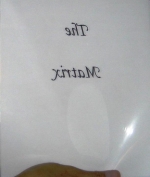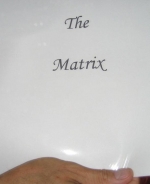Attempting to explain the operation of the simplest optical device known to man, was the practical demonstration in my Inaugural Lecture at the University of Southampton, which took place on May 18th 2005.
The “Eureka” moment as the mirror’s ability to laterally invert text was seen to be illusory caused quite a stir in the audience and was a talking point for colleagues for weeks afterwards.
I chose this particular experiment as amongst other things, batteries and power were not necessary. I had seen from my colleagues’ previous Inaugural Lectures that anything that can go wrong will go wrong, especially if electrical power is involved.
Everyone is familiar with the mirror’s apparent ability to laterally invert text which gives rise to so-called “mirror writing”. I had always been unhappy with discussions about lateral inversion in mirrors, especially since as far as I was concerned all a mirror did was reflect light and I could see no mechanism for laterally inverting objects as well. So a couple of years before giving the Inaugural Lecture I decided to apply the scientific method to lateral inversion in mirrors and resolve the “mirror problem” to my satisfaction.
| Figure 1: Showing expected lateral inversion |
Figure 1 shows the reflection of “The Matrix” in a mirror (I use the same words that I used in the Lecture as the underlying theme was questioning what we call “reality”). As you can clearly see, since the camera does not lie, “The Matrix” appears laterally inverted when you look at the words in the mirror – absolutely nothing strange there, we see this every day.
But a mirror simply sends light back to the object, assuming the object lies perpendicularly in front of the mirror, so where does the lateral inversion come from?
Write or print “The Matrix” on a piece of paper and hold the text up in front of your eyes, you can see “The Matrix” quite clearly – no lateral inversion at all. Now rotate the paper 180 degrees so it is facing a mirror and look into the mirror, you now see “The Matrix” laterally inverted, and you may also have seen where the inversion came from.
Did you catch it?
You rotated the text yourself when presenting it to the mirror, the mirror then simply send back what it “sees”, and it “sees” laterally inverted text, because you just inverted it.
Now, to be fair, I was not the first person to notice this, although I didn’t know so at the time. I was in fact preceded by Martin Gardner who wrote mathematical puzzles for Scientific American, and he discusses mirror inversion of writing in his book “The Ambidextrous Universe” ((“The Ambidextrous Universe”, Martin Gardner, Pelican books 1970, ISBN 0 14 02.1081 4)).
Gardner also provides three interesting references on this subject ((“The Difference Between Right and Left”, American Philosophical Quarterly, vol.7, July 1970)) ((“Why Do Mirrors Reverse Right/Left but Not Up/Down?”, Journal of Philosophy, vol.71, May 16, 1974)) ((“Through the Looking Glass”, Philosophical Review, vol.86, January 1977)), one which says the above description is correct ((ref:2)) , and two which think the description is totally incorrect ((ref:3)) ((ref:4)). However, I feel I am able to offer a little more practical explanation than was given by Gardner in his book and this is what caused the general hubbub in the audience on the day of the lecture.
You will see from Figure 1 that I printed “The Matrix” on clear acetate sheet. Why? Because if it is simply the case that I caused the lateral inversion by rotating the page towards the mirror, then I can rotate the page 180 degrees (and still see the writing as it is on acetate) before presenting it to the mirror, and if the above description of what is happening is correct, I will see “The Matrix” non-inverted in the mirror. Figure 2 shows the results of this part of the experiment.
| Figure 2: Showing non-inverted text |
The title of my Inaugural Lecture was “Indistinguishable from Magic” (with thanks to Arthur C Clarke who proposed that any sufficiently advanced technology is indistinguishable from magic). I thought the demonstration was particularly apt, as along with smoke, mirrors are often associated with magic. It’s very nice to see a problem such as this arising simply because we hadn’t understood the correct frame of reference.




In trying to teach physics in 7th grade, I found your explanation fabulous. My children began to discuss the reflection, say in a lake of tress and clouds and the lateral flip got mixed up with the upside down. Any comment or helpful suggestions. Thanx
Pingback: New Forest Observatory » Mirrors really are Magic!!!
You have some very bright, and very observant children there Elizabeth! I have just opened up a new article on this problem since in my ignorance I had really thought I’d answered this one fully! I wouldn’t have believed for a moment that lying a mirror horizontally would make any difference at all, but as you say, the image in the mirror (which could be a lake) not only laterally inverts, but also top/bottom inverts as well. How very interesting!!!
Greg
This isn’t really a mystery. It can be easily explained by pointing out that an object on the left side of the mirror will create images on the left side of the mirror. Objects on the top will create images at the top. Objects on the right side will stay on the right side.
If you look at yourself you will see an image of yourself that is facing the opposite direction you are. Your feet will still be creating and image on the bottom of the mirror. Your head will still make an image on the top of the mirror.
The reason for left – right inversion and no top bottom inversion is the same reason you don’t fall upside down every time you turn around. Your feet stay on the ground, but your hands on different sides of your body.
I guess from your comments that you haven’t read the later post on “How a mirror REALLY works”? A mirror does indeed invert top/bottom as well as left right, but you only get the left/right inversion when the mirror is in the same vertical plane as yourself. In the more general case where the mirror is in the plane perpendicular to the object – things get a lot more interesting.
(wow missed this conversation by a good two years but oh well i’ll leave the comment anyway. maybe someone will reply.)
So i was going to leave a comment and throw Steve some support. I really don’t understand the hooplah about lateral inversion. it’s just like stage right and stage left, it’s only relative to where you’re standing. But i guess that is the point of a lecture about what we consider reality. So i went to go read about what Elizabeth posted and your response about top to bottom inversion. I still felt the same, like what’s the big deal? That’s just how reflections work, like steve said – objects on the right are still on the right and same with the left and so on… However, those only apply to situations when the mirror is on a level plane. Elizabth’s students thought to lay the mirror down, what if the mirror was at a 45 degree angle or- what about a funhouse mirror? When it can be on many planes and bend at lots of different angles? is there a certain type of inversion for that? or is that just classified as a combniation of many left-right up-down inversions?
I still feel like Steve, no mystery here. but im willing to admit im probably missing something. Are we just over explaining common sense or is there really a deeper universal meaning to all of this?
You can imagine mirror-reversed as “looking from behind”: A person behind you would see you mirror-reversed if you were as thin and transparent as a color slide. And turning a color slide means you look at it from the other side, and the usual horizontal turn only reverses left and right. While a vertical turn reverses up and down, and things on the left (or right) stay on the left (or right).
I once knew a student of art history, and he showed me an old painting with stars on it, and asked me about the depicted constellations. The stars looked familiar, but somehow totally wrong – until I detected the conspicuous Delphinus among them. Once I realized the image was mirror-reversed I could name the constellations. But why mirror-reversed? It was an old religious painting, and the perspective was that of God – looking at the sky from the other side.